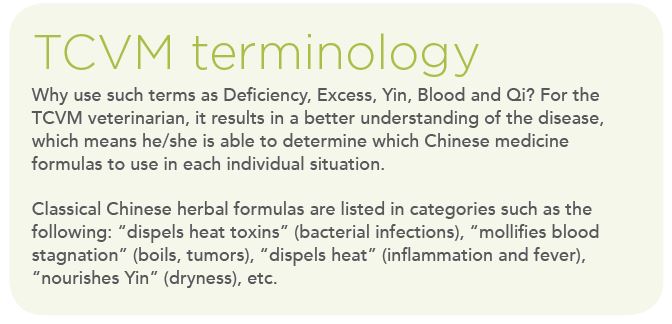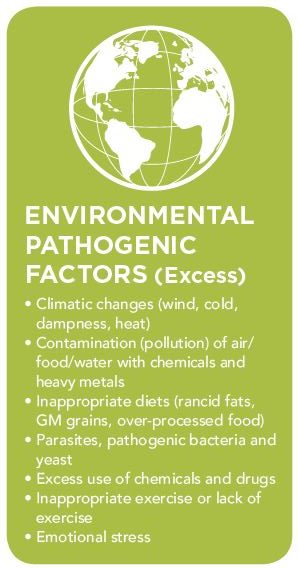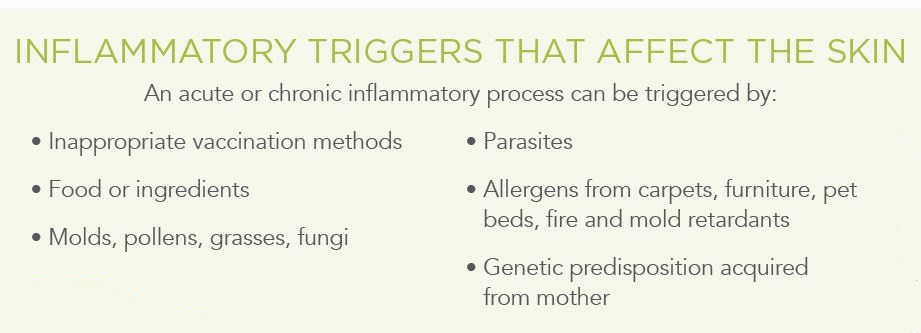TCVM approaches to skin problems in dogs and cats

Traditional Chinese Veterinary Medicine (TCVM) uses the concept of Excess and Deficiency to get to the root of your dog or cat’s skin problems – and treat it effectively.
Skin problems such as hot spots, itching, dryness or alopecia are common in dogs and cats. There are lots of alternative ways to alleviate these issues without turning to conventional medications. In this article, we’ll focus on the Traditional Chinese Veterinary Medicine (TCVM) approach – specifically the concept of Excess versus Deficiency — and how it can effectively treat skin problems in your dog or cat.
The conventional approach offers no cure
The most frustrating skin problems your veterinarian sees are the chronic ones that have been treated with the conventional medicine paradigm of “attack and kill” (using antibiotics) and “suppressing the hyperactive immune system” (using steroids, antihistamines, chemotherapy). Unfortunately, these therapies offer no cure, and result in side effects and a lot of expense.
If you’re like a lot of veterinary clients, you’ve probably gone to an integrative or holistic veterinarian for a second or third opinion. Different vets use a variety of alternative approaches to canine and feline skin problems, and Traditional Chinese Veterinary Medicine (TCVM) is often one of them.
In TCM and TCVM, the focus is on the individual and the specific symptoms causing “dis-ease”. Although immuno-suppressive drugs will make a dog or cat comfortable, they don’t focus on the animal’s needs for repair, regeneration and function restoration.
 The TCVM paradigm of Excess and Deficiency
The TCVM paradigm of Excess and Deficiency
Transitioning a dog or cat from a conventional treatment plan to a more holistic paradigm can be challenging, but the TCVM approach of Excess and Deficiency can bring clarity to the veterinarian, and to you as the client. This approach offers a broader perspective on the supplements, herbal formulas and topical treatments the dog or cat should be given.
The Deficiency versus Excess system involves a careful examination of the patient by the veterinarian, who studies the dog or cat’s past history and integrates pulse and tongue diagnosis into his/her observations during the physical exam. The TCVM system categorizes the patient’s symptoms and state of health by looking for Deficiency (metabolically, nutritionally, immunologically, etc.) and Excess, which is reflected in the symptoms (itching, inflammation, dryness, etc.) as well as in contributing and aggravating factors (Heat, Damp, Wind, Dryness, Cold). The veterinarian then can begin to create a treatment plan that works.
This system has many advantages:
- Provides a clear organization of the symptoms to study, helping the vet look for the source of the problems that developed into the current skin issue
- Gives a view of the “bigger picture” — the animal’s life progression and how degenerative changes manifested over time
- Makes it easier to organize the choices of Chinese or Western herbs to quell symptoms, and supplements to restore and repair the problems
- Clarifies which kinds of food would benefit the dog or cat, and which would or would not possibly aggravate the current problem
- Provides clarity on the necessity to “detox” or “tonify” the animal.
Homeostasis and the connection between Deficiency and Excess
 One of the fundamentals of Asian Traditional Medicine is that of homeostasis. When homeostasis is “in balance”, the animal experiences healthy normal functioning within his cells, tissues and organs, as well as between his organ systems and with the environment (pathogenic factors – see sidebar at right).
One of the fundamentals of Asian Traditional Medicine is that of homeostasis. When homeostasis is “in balance”, the animal experiences healthy normal functioning within his cells, tissues and organs, as well as between his organ systems and with the environment (pathogenic factors – see sidebar at right).
When Excess from environmental factors affects a living being, the body will initially create symptoms of Excess, such as boils, rashes, abscesses, swellings and oozing sores. If the Excess factors are not resolved and become chronic, the internal environment of the animal becomes afflicted with Deficiencies (Yin, Yang, Blood, Qi) which can lead to other disharmonies and symptoms. Yin represents the organs of the spleen, liver, kidneys, heart and lungs, and all bodily (cellular) fluids, whereas Yang represents the stomach, intestines, gall bladder and urinary bladder. Yang can also represent Heat and Wind, whereas Yin can relate to Cold, Wet and Damp weather — or these conditions within the body. Qi can be explained as Vital Energy, and the Blood includes both red and white blood cells.
Excess is generally associated “with an abundance or surplus of external atmospheric or pathogenic factors”. An “accumulation of Excess” usually refers to:
- Bacterial and/or fungal infections (causing inflammation)
- Hyperactive immune system reacting to allergens in the food or environment, causing generalized inflammation.
- Improper diet, resulting in excessive formation and buildup of toxic metabolic waste byproducts in the skin (boils, pustules, swellings)
- “Stagnation of Blood”, causing a tumor (mast cell) or the formation of nodules.
An Excess condition might have arisen from an underlying Deficiency such as poor immune system function (Wei Qi Deficiency); GI microbiome imbalance and hypofunction (Spleen Qi Deficiency); a lack of antioxidants to help detoxify (Liver Yin Deficiency); or genetic susceptibility.

Physiological manifestations of Deficiency
Skin healing that is delayed or ineffectual is just one of the physiological manifestations of Deficiency. They can also include hypofunction or diminished capacity of any organ or physiological process, decreased resistance to stress or infection, and persistent generalized or localized feelings of fatigue, weakness or emptiness. These issues can be detected by medical history, observations via examination, lab tests, and by using TCVM tongue color and pulse diagnosis.
Following are some of the most common skin symptoms seen in Deficiency states of health. Herbal formulas, vitamins, minerals and medicated baths can help support these Deficencies:
- Dry skin, lusterless coat (lack of essential oils internally)
- Chronic alopecia (hypothyroidism)
- Skin that feels cool (hypothyroidism)
- Skin that has dry flakes, with or without pruritis
- Lichenification
- Hyperkeratosis, acanthosis nigricans (hormonal)
- Dry eyes, dullness, possibly crusty discharge
Additionally, here is a list of the most common diseases in the category of “Skin Problems due to Deficiency States”:
- Hypothyroidism
- Hypoadrenocorticism
- Hypogonadism
- Hyperproliferative epidermal disorders
- Nutritional deficiencies
- Congenital and hereditary diseases (e.g. canine recurrent flank alopecia, affecting Airedale terriers, English bulldogs, boxers, miniature Schnauzers, miniature poodles, Dobermans, Bouviers, Scottish terriers, Staffordshire bull terriers, French bulldogs and Affenpinschers)
Treating skin conditions caused by underlying Deficiencies
By only treating the symptoms (or Excess), your dog or cat will see some relief, but the problems will recur if the underlying Deficiencies are not mollified. Here is a general treatment plan for a skin condition due to an underlying Deficiency.
1. Increase immune system activity — Wei Qi, herbal formulas and acupuncture
2. Improve digestive function — Spleen Qi tonics, probiotics, prebiotic foods
3. Recognize and tonify Deficiencies
4. Improve detoxification (Liver, Blood, Kidney, Colon) — Antioxidants and liver support, probiotics, topical baths and rinses
5. Mollify inflammation (modulate immune system release of cytokines) –quercetin, Chinese herbal formulas, Omega-3, probiotics, acupuncture
6. Dispel “invading pathogenic factors” (Wind, Heat, Damp, “Fire toxins” (bacteria)) — topical and oral herbs, herbal antibiotics, Chinese herbal formulas
7. Repair, regenerate and restore healthy skin — Zinc, Omega-3, collagen, aloe vera, comfrey, vitamins C, E and D
In summary, TCVM offers many advantages when it comes to treating skin problems in dogs and cats. To start with, unlike the conventional approach, it treats the individual, not just the symptoms. It also yields better cure rates, treats the underlying conditions leading to the skin problem, improves immune system and microbiome function along with overall health, and fortifies Deficiencies in the animal’s body and diet.
As you can deduce from this article, it’s important to work with a veterinarian who is trained in TCVM when addressing your dog or cat’s skin problems. While it’s not a quick fix, it’s an effective approach that doesn’t just mask symptoms, and is is far more likely to result in a cure.



